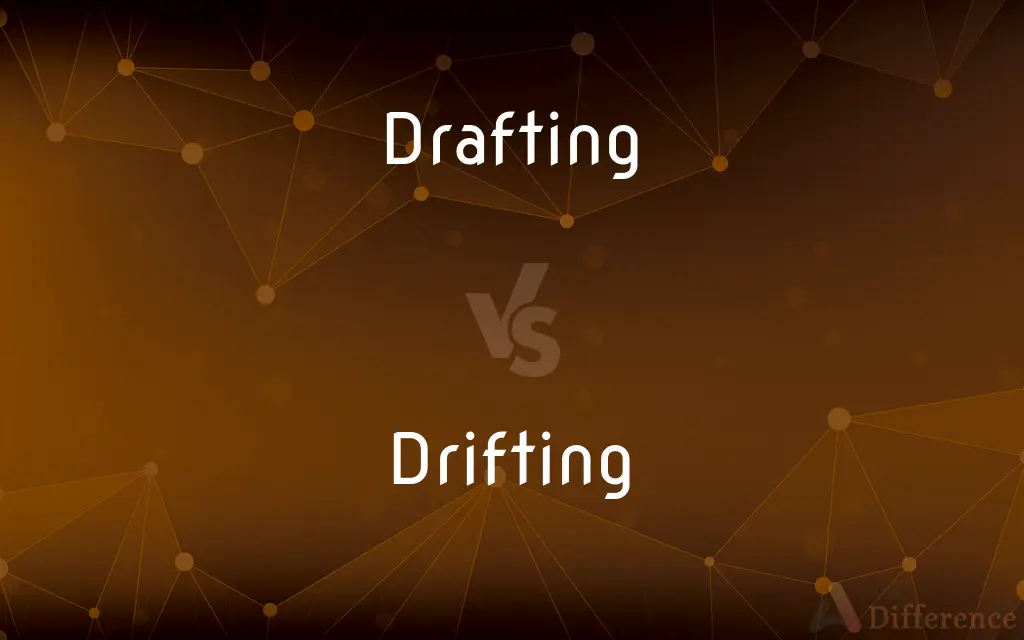Drafting vs. Drifting — What's the Difference?
By Tayyaba Rehman & Urooj Arif — Updated on April 5, 2024
Drafting is a strategic technique used in racing to reduce air resistance, while drifting involves intentionally oversteering during turns to maintain speed.

Difference Between Drafting and Drifting
Table of Contents
ADVERTISEMENT
Key Differences
Drafting, often seen in cycling and motorsports, is a technique where competitors stay close behind another to benefit from reduced air resistance. On the other hand, drifting is a driving technique used primarily in motorsports where the driver intentionally oversteers, causing the rear wheels or all the wheels to skid, though it's controlled to manage the car's direction.
While drafting is used to conserve energy or fuel by taking advantage of the slipstream created by the leading vehicle, drifting is employed to navigate turns at high speed efficiently, maintaining momentum and not necessarily conserving energy. Drafting requires precise positioning and timing to gain the maximum advantage without compromising safety, whereas drifting demands a high skill level to control the car's balance and trajectory during the oversteer.
Drafting is strategic, with participants often working together until a critical moment when they attempt to outpace the competition. Drifting, while it can be competitive, is also judged on style, execution, and speed, reflecting a blend of sport and art.
In sports where drafting is applicable, it's all about minimizing drag to improve speed and efficiency, making it common in races like NASCAR or cycling events. Drifting, conversely, is highlighted in sports and competitions dedicated to the technique itself, such as drift racing events, where the focus is on the driver's ability to control the car while it's essentially out of traditional control.
Comparison Chart
Purpose
To reduce air resistance and conserve energy.
To maintain speed through turns with style.
ADVERTISEMENT
Technique
Following closely behind another competitor.
Intentionally oversteering to skid turns.
Primary Use
Cycling, NASCAR, and other racing sports.
Drift racing and performance driving.
Skill Required
Strategic positioning and timing.
High vehicle control and balance.
Energy Efficiency
High, due to reduced air resistance.
Lower, as it focuses on speed, not saving fuel.
Compare with Definitions
Drafting
Drafting is a strategy used in racing to stay behind a competitor to reduce wind resistance.
In the cycling race, Emma used drafting behind the lead racer to conserve energy.
Drifting
Drifting is the technique of oversteering through turns while maintaining control.
The driver expertly drifted through the corners, thrilling the audience.
Drafting
Drafting can lead to significant energy or fuel savings over time.
By drafting behind larger vehicles, the cyclist reduced his effort significantly.
Drifting
It is judged on execution, style, and speed in competitions.
In the drifting competition, precision and flair determined the winner.
Drafting
It requires precise timing and positioning to be effective.
The NASCAR driver waited for the final lap to break from drafting and take the lead.
Drifting
Modifications to cars are often necessary for effective drifting.
To improve his drifting, Sara upgraded her car's suspension and tires.
Drafting
Team strategies often involve drafting to support a lead racer.
The cycling team used drafting to protect their sprinter until the end.
Drifting
Drifting requires a high level of skill to balance the car.
Mastering the art of drifting took Alex years of practice.
Drafting
Safety and communication are crucial to avoid accidents while drafting.
During the race, riders signaled each other when intending to shift positions in the drafting line.
Drifting
Drift racing focuses on the driver's ability to control slides.
The drift racer's skill at maintaining a controlled slide won them the race.
Drafting
The systematic representation and dimensional specification of mechanical and architectural structures.
Drifting
A technique in motorsports in which the driver briefly oversteers at the start of a turn, causing the rear of the vehicle to enter a controlled lateral skid until the turn is complete.
Drafting
Present participle of draft
Drifting
A competitive sport based on this technique.
Drafting
The act or process of producing a technical drawing, or draft.
Drifting
Moving aimlessly or at the mercy of external forces.
The drifting seaweed went wherever the currents carried it.
Drafting
A profession, usually related to making technical drawings for architecture, engineering, or manufacturing.
Drifting
Without direction, focus, or goal.
Drafting
The practice among ground vehicle drivers or cyclists of following in a close line to reduce wind resistance.
Drifting
The act by which something drifts.
Drafting
A method of preparing fibers for weaving.
Drifting
That which drifts.
Drafting
Writing a first version to be filled out and polished later.
Drifting
(motorsports) A driving technique where the driver intentionally oversteers, causing loss of traction in the rear wheels, while maintaining control from entry to exit of a corner.
Drafting
The craft of drawing blueprints.
Drifting
Present participle of drift
Drafting
A creation of artistic drawings.
Drifting
Aimless wandering from place to place
Drafting
Writing a first version to be filled out and polished later
Drifting
Continually changing especially as from one abode or occupation to another;
A drifting double-dealer
The floating population
Vagrant hippies of the sixties
Drafting
The craft of drawing blueprints
Drifting
Afloat on the surface of a body of water;
After the storm the boats were adrift
Drafting
The creation of artistic drawings;
He learned drawing from his father
Common Curiosities
How does drafting benefit racers?
It conserves energy or fuel by reducing air resistance, allowing racers to travel faster with less effort.
Can drafting be dangerous?
Yes, drafting can be dangerous if not executed with precise timing and spacing, leading to potential collisions.
What is drafting?
Drafting is a technique used in racing where a competitor stays close behind another to reduce air resistance.
Do all racers use drafting?
Not all racers use drafting; its effectiveness depends on the type of racing and the rules governing the sport.
Why is drifting used in motorsports?
Drifting helps maintain higher speeds through corners and is also judged as a competitive sport for its style and skill.
Is drafting only used in car racing?
No, drafting is widely used in cycling and other forms of racing where air resistance plays a significant role.
What is drifting?
Drifting is a driving technique where the driver intentionally oversteers to skid through turns while maintaining control.
What skills are required for drifting?
Drifting requires advanced driving skills, including vehicle control, balance, and the ability to manage oversteer.
What are the risks of drifting?
Drifting carries risks of losing vehicle control, accidents, and increased wear on the car.
Are special cars needed for drifting?
While many cars can drift, professional drifting often involves modified vehicles for better performance and control.
How do judges score drifting competitions?
Judges score based on the angle and speed of the drift, the driver's skill in maintaining control, and the style.
Is drifting considered a form of art or a racing technique?
Drifting is seen as both an art form, due to its emphasis on style and skill, and a racing technique for its strategic use in competitions.
How do teams use drafting in team sports like cycling?
Teams use drafting to conserve the energy of key racers, setting them up for a strong finish.
Can drifting be practiced on all types of roads?
Practicing drifting requires specific conditions for safety and legality, often on closed tracks or designated areas.
Can drafting lead to faster overall race times?
Yes, drafting can lead to faster times by reducing the effort needed to overcome air resistance.
Share Your Discovery

Previous Comparison
Overlap vs. Overlay
Next Comparison
Introduction vs. PreliminaryAuthor Spotlight
Written by
Tayyaba RehmanTayyaba Rehman is a distinguished writer, currently serving as a primary contributor to askdifference.com. As a researcher in semantics and etymology, Tayyaba's passion for the complexity of languages and their distinctions has found a perfect home on the platform. Tayyaba delves into the intricacies of language, distinguishing between commonly confused words and phrases, thereby providing clarity for readers worldwide.
Co-written by
Urooj ArifUrooj is a skilled content writer at Ask Difference, known for her exceptional ability to simplify complex topics into engaging and informative content. With a passion for research and a flair for clear, concise writing, she consistently delivers articles that resonate with our diverse audience.
















































